
Improving a guitar

![[Previous Page]](prev.gif)
![[Next Page]](next.gif)
![[Up]](up.gif)
![[Home Page]](home.gif)
![[Mail]](mail.gif)
![[Contents]](contents.gif)

I have found a Squire Stratocaster for a great price, which plays really nicely. The body of many Squires (and other cheap guitars) is made from plywood. This body is solid wood, though. The only drawback is the poor electric circuitry and the crapy pickups.
I want to install better pickups, and to reduce the noise of the Squire by slightly modifying the wiring and shielding the body internaly.
I do not recommend doung this modifications on a hollow body guitar. I wouldn't want to apply that conductive paint inside of that kind of body. It will definately reduce the value of this kind of guitar.
The new pickups are a Bartolini humbucker LCE5J for a warm, jazzy sound at neck position, a Seymour Duncan STK-S1 single coil for the middle position and a Seymour Duncan SCR-1 Cool Rails single coil sized humbucker for the bridge position.
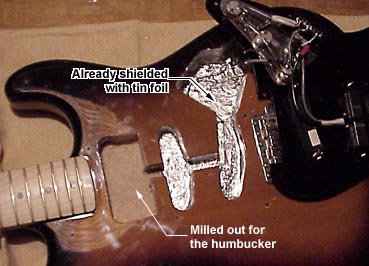
|
The body had to be milled or carved out for the humbucker at the neck. I have used a drill and a carving knife for that task. |
|
The copper based paint is a spray that is used for shielding non-conductive housings of electric devices to reduce the electromagnetic interferences. It is available at stores like Radioshack. |
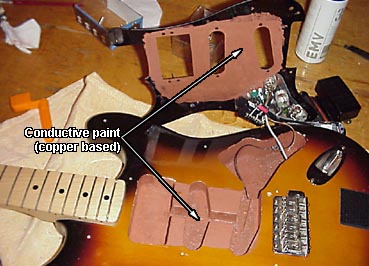
|
|
Old circuitry 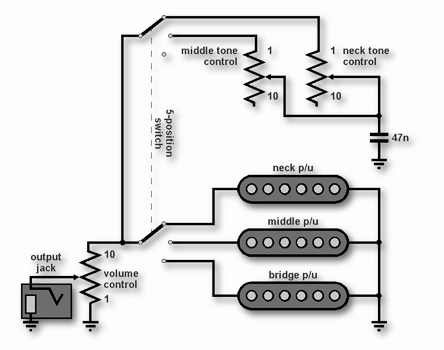
| |
|
All pots are 250k/log. The tone controls work like kinda shortcutting high frequencies depending on what you have dialed in on the pots. A capacitor has an impedance that is the lower the higher the frequency is that flows through the capacitor. Depending on what pickup(s) are selected by the 5-position switch, one or the other tone control is active. There is no tone control for the bridge pickup. BTW: the above schematic does not represent the way how the 5-position switch works. Actually the two positions that activate two pickups (neck + middle and middle + bridge) activate the associated tone controls too.
|
|
|
New circuitry 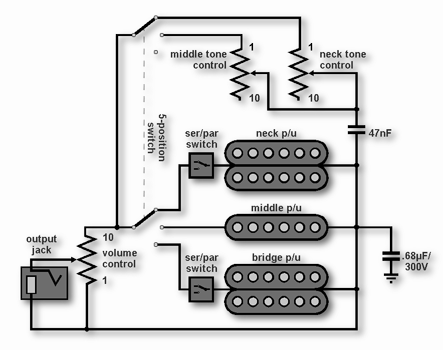
|
|
|
The main differences of the new circuitry are the humbuckers at the neck abd bridge position, serial/parallel switches for those humbuckers and the elimination of the ground loops. Everything is directly connectd to a virtual ground (one pin of a capacitor (0.68µF/300V). This capacitor increases the safty if the guitar too. In case yer amp turns into a killer amp, the DC is not directly connected to the guitar's ground, the bridge and the strings. This is why the capacitor is at least a 300V type. |
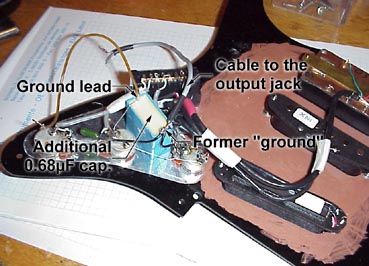
|
The additional capacitor is glued to the pick guard. All wires that were formerly connected to the ground are now connected to one lead if this capacitor. The housings of the pots are connected to the new ground lead. The cables to the output jack is replaced by a shielded cable. It's shield is connected to the "former ground". |
|
An eye is soldered to the end of the cable to the bridge and to the ground lead. Those cables are screwed into the body to provide a connection to the shielding which is formed by the conductive paint. |
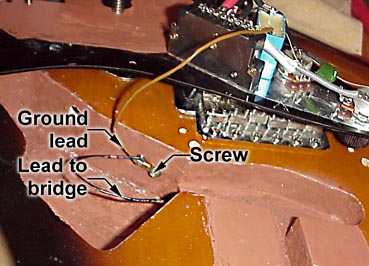
|
The result is awesome. The new pickups sound really great. Just like what I have desired. Special thanks to the guy in the store, who has discussed the pickups to choose with me. They are an excelent choise.
With the former shielding (tin foil) the hum is definately reduced, but it was still annoying, especially when I was sitting in fromt of the computer. Monitors just introduce lotsa noise to guitar pickups.
After removing the tin foil, applying the copper based paint and modifying the circuitry like described before, you can hardly hear any hum. It becomes noticeable when I hold the guitar really close to the monitor (maybe 4 or 5 inches).
I think, this good result is matter of shielding the pick guard too and of the modified circuitry. The tin foil might be as good for shielding a guitar. Applying the paint is faster and the layer is thinner, which is better for shielding the pick guard.
Now I would consider this cheap Squire to be a very versatile , good sounding guitar suitable for using it in the studios. It just required some hours of work and the investment in better pickups.
I would recommend those modifications to everybody who feels comfortable with soldering and simple schematics and who wants to modifiy a stratocaster like guitar.

| [Previous] | Some words about pickups |
| [Next] | Stringing a guitar |
| [Up] | Home Page |
| [Home] | Home Page |
| [Mail] | Send EMail to Sven's Guitar Zone |
| [Contents] | Sven's Guitar Zone Contents |

Last modified on Wednesday, 22. February 2006